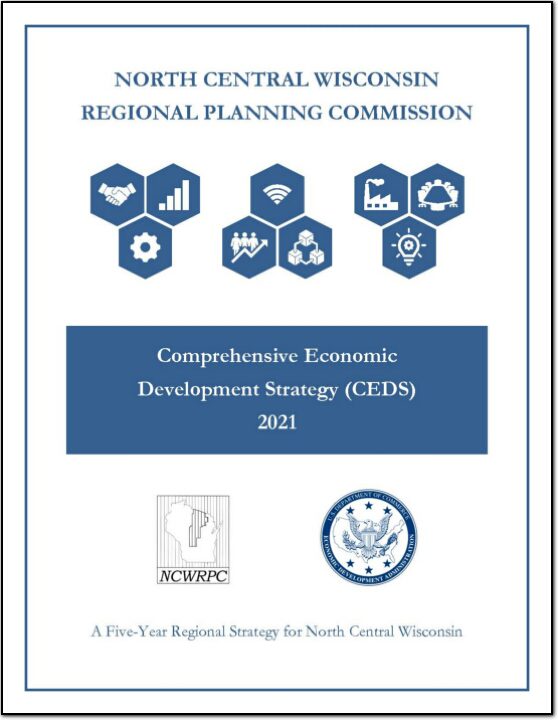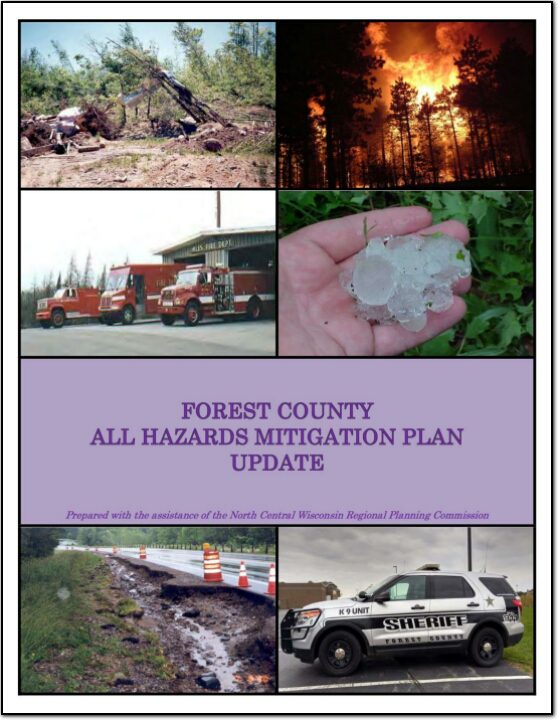Lincoln County
Loretta Baughan
Lincoln County
Ronald Nye
Langlade County
Angela Close
Langlade County
Paul Millan
Forest County
NCWRPC News Winter 2021 – Issue 71
Comprehensive Economic Development Strategy 2021
The purpose of the CEDS is multifaceted. The CEDS is designed to provide baseline information on demographics and economic data, development of strategies, and identify potential projects within the Region. Preparation and adoption of the CEDS maintains both the Region’s EDD designation, but also maintains grant eligibility for those participating units of government. This CEDS process maintains the Region’s eligibility as an Economic Development District (EDD) with the U.S. Economic Development Administration. The District consists of ten counties. These counties are Adams, Forest, Juneau, Langlade, Lincoln, Marathon, Oneida, Portage, Vilas, and Wood.

Forest County All Hazards Mitigation Plan Update 2021
Part I of the Forest County All Hazards Mitigation Plan (AHMP) Update describes and documents the process used to develop the Plan Update. This includes how it was prepared and who (committee, organizations, departments, staff, consultants, etc.) was involved in the update process. It also describes the local governments involvement, the time period in which the update was prepared, and who to contact to answer questions and make recommendations for future amendments to the Plan.

Merrill Safe Routes To School
Safe Routes to School (SRTS) programs are an opportunity to make walking and bicycling to school safer for children in grades K-8, and to increase the number of children who choose to walk and bicycle. On a broader level, SRTS programs can enhance children’s health and well-being, ease traffic congestion near the school, and improve community members’ overall quality of life.
In 2016, 10 school districts won a WisDOT SRTS planning grant as part of the North Central Wisconsin Regional SRTS Program, administered by NCWRPC.
In the fall of 2019-2020, the City of Merrill, and the Merrill School District began SRTS Planning with the assistance of the North Central Wisconsin Regional Planning Commission (NCWRPC). The NCWRPC will guide the Merrill SRTS Task Force through the planning process.
The following schools are part of SRTS planning:
- Jefferson Elementary School (K-5);
- Kate Goodrich Elementary School (K-5);
- Washington Elementary School (K-5);
- Prairie River Middle School (6-8); and
- Merrill High School (9-12);
The Merrill Safe Routes To School (SRTS) Task Force consists of people from the schools, law enforcement, local government officials, and local residents.
Resources
Pedestrian Safety
Bicycle Safety
PSAs
Merrill SRTS Plan
Merrill SRTS Plan (without maps)
Full Adopted Merrill SRTS Plan with all maps & attachments
Prairie River Middle School
Map 3A – Site Assessment
Map 4A – Transportation
Map 5A – School Routes
Map 6A – Recommendations
PRMS SRTS Action Plan
Jefferson Elementary School
Map 3B – Site Assessment
Map 4B – Transportation
Map 5B – School Routes
Map 6B – Recommendations
Jefferson Elementary SRTS Action Plan
Kate Goodrich Elementary School
Map 3C – Site Assessment
Map 4C – Transportation
Map 5C – School Routes
Map 6C – Recommendations
Kate Goodrich Elementary SRTS Action Plan
Washington Elementary School
Map 3D – Site Assessment
Map 4D – Transportation
Map 5D – School Routes
Map 6D – Recommendations
Washington Elementary SRTS Action Plan
Merrill High School
Map 3E – Site Assessment
Map 4E – Transportation
Map 5E – School Routes
Map 6E – Recommendations
Merrill High School SRTS Action Plan
Attachments:
A – Student Tally & Parent Survey forms
B – 2019 Results from Student Tallies & Parent Surveys
C – SRTS Task Force Meetings and Adoption Documentation
D – Bicycle Parking Guidelines
E – Three Factors Increase Walking and Biking–CDC
Make questions or comments about the planning here.
(Email link to submit comments on this plan.)
Transportation Planning
The NCWRPC assists local governments in the preparation of local road improvement programs. These road plans provide a capital improvement schedule for upgrading local roads and help local units obtain LRIP funding for road reconstruction projects. Pavement rating and other assistance with the WISLR program is also available.
In addition, the NCWRPC conducts specialized transportation studies including Safe Routes To School plans, bicycle and pedestrian system plans, traffic counts, and others.
What Types of Services are Provided?
Local Road Improvement Programs
· Counties
· Cities
· Villages
· Towns
WISLR Assistance
Road Rating Assistance and Training
Safe Routes to School Planning and Assistance
Bicycle Facilities Planning
WisDOT Traffic Count Data
Access Management Studies
Alternative Route Studies
Corridor Studies
License Plate Surveys
Parking Surveys and Studies
Specialized Studies and Surveys
Identifying Sources of Assistance
Preparing Grant Applications for Federal/State Programs
Transportation and Land Use Planning:
The NCWRPC provides professional planning assistance in the areas of land use management and policy development, zoning, subdivision and other regulations, as they relate to transportation systems.
Because of the close relationship between land use and transportation, the transportation planning process involves the planning of land uses as well as transportation systems and facilities.
Specialized Studies:
NCWRPC Staff assists local units of government to identify transportation problems and develop viable solutions. Services can range from preparing a study or plan to securing financing for community projects to drafting an ordinance.
Title VI Notice
Non-Discrimination Policy Statement
The NCWRPC operates its programs and services without regard to race, color, age, sex, disability, low income, limited English proficiency, and national origin in accordance with the Title VI of the Civil Rights Act.
Contact Darryl Landeau, Transportation Planner, 715-849-5510, dlandeau@ncwrpc.org with any questions.
North Central WI Regional Planning Commission (NCWRPC)
Title VI and Non-Discrimination Program / Limited English Proficiency Plan
If information is needed in another language, contact 715-849-5510.
Si se necesita informacion en otro idioma de contacto, 715-849-5510.
Yog tias cov ntaub ntawv uas yuav tsum tau ua lwm hom lus, hu rau, 715-849-5510.
Title VI Complaint and Comment Form